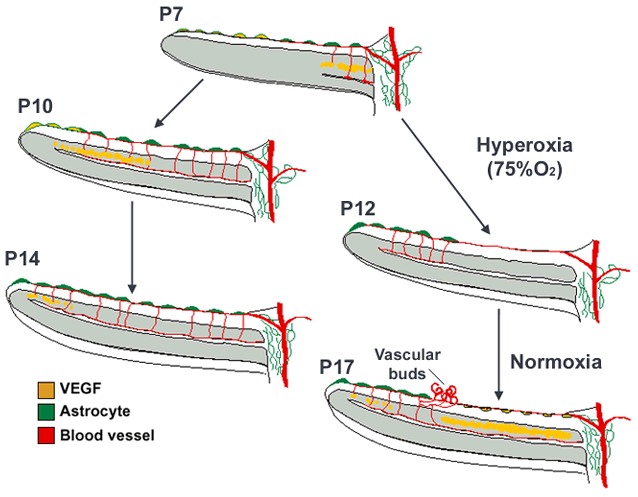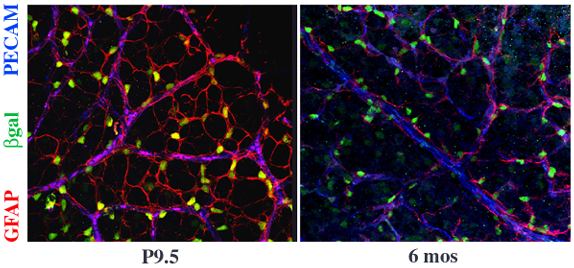![]() Figure 5 of
Lutty, Mol Vis 2006;
12:532-580.
Figure 5 of
Lutty, Mol Vis 2006;
12:532-580.
Figure 5. VEGF and its isoforms in retinal development, oxygen-induced retinopathy, and adult retinal vasculature
A: Mouse model of retinal vascularization and ROP (adapted from Stone et al. [8]). During normal retinal development (left side of panel A), maturation of the neural retina induces a "physiologic hypoxia" anterior to the growing vessel tips. Astrocytes spreading from the optic nerve to the periphery respond to the hypoxia by expressing vascular endothelial growth factor (VEGF), which in turn promotes the formation of the superficial vascular network. Subsequently, a second wave of neuronal activation induces VEGF secretion in the inner nuclear layer, leading to the formation of the deep vascular layers of the retina. Once the tissue is vascularized, VEGF expression decreases and the new vessels are remodeled and stabilized. Under hyperoxic conditions (drawings to the right), VEGF expression is downregulated before the completion of the normal vascular development, leading to the obliteration of the central retinal vessels. Once returned to normoxia, the unperfused tissue becomes highly hypoxic, inducing a strong and uncontrolled secretion of VEGF and the formation of vascular buds invading the vitreous, characteristic of the pathological neovascularization. B: Localization of VEGF in developing and adult retinal vasculature. Retinas from P9.5 and 6 months old VEGF-lacZ+/- mice were co-stained for βgal expression in combination with astrocytes and endothelial cell-associated proteins (GFAP and PECAM, respectively). Numerous βgal-positive nuclei, reflecting VEGF expression, can be observed in both developing and mature retina. βgal-positive nuclei are not all co-localized with GFAP staining, some are characteristically associated with the vessels in a pattern characteristic of pericytes, indicating pericytes producing VEGF. C: Quantification of VEGF mRNA isoforms levels in adult mouse organs using RNase protection assay. The height of the columns represent the levels of total VEGF mRNA, and the relative levels of different VEGF isoforms are indicated in the divisions. Both level of total VEGF mRNA and relative VEGF isoforms expression varies among tissues.
A: Republished with permission of the University of the Basque Country Press from Saint-Geniez M, D'Amore PA. Development and pathology of the hyaloid, choroidal and retinal vasculature. Int J Dev Biol 2004; 48:1045-58. B: Republished with permission of Elsevier from Darland DC, Massingham LJ, Smith SR, Piek E, Saint-Geniez M, D'Amore PA. Pericyte production of cell-associated VEGF is differentiation-dependent and is associated with endothelial survival. Dev Biol 2003; 264:275-88. C: Republished with permission of Wiley-Liss, Inc., a subsidiary of John Wiley and Sons, Inc., from Ng YS, Rohan R, Sunday ME, Demello DE, D'Amore PA. Differential expression of VEGF isoforms in mouse during development and in the adult. Dev Dyn 2001; 220:112-21.
A:

B:

C:
